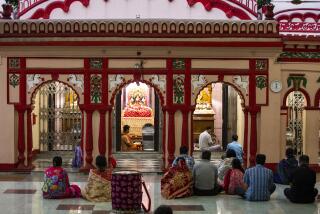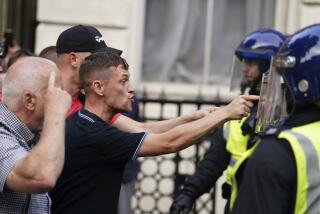Poverty Set Volatile Stage for Race Riots in Britain
- Share via
OLDHAM, England — The shattered windows of the Live and Let Live pub have been boarded up. The burned-out automobile carcasses and police barricades have been removed since Britain’s worst race riots in decades broke out last weekend.
But the rage that fueled two nights of pitched street battles between police officers and Pakistani and Bangladeshi youths is still simmering. The wounds inflicted on all sectors of this deeply segregated town on the outskirts of Manchester are open.
“We are a part of this country. I have four children born here,” said Abu Khalid, 34, a teacher at the Nusrat-ul-Islam mosque. “We have to respect the laws and people of this country. But at the same time, we have to defend our dignity, our culture and our community.”
Police and community workers want to make it through the coming weekend before they will declare the rioting over. Officials are concerned that right-wing extremists will try to provoke racial violence at an England-Pakistan cricket test match today in Manchester, about 10 miles away. The Pakistani team will be given police protection to and from the stadium.
In the meantime, Oldham residents and officials are trading blame for the riots that broke out Saturday night in which angry youths fought police with bricks and firebombs. Fifteen officers and 10 civilians were injured during clashes that were reminiscent of London’s Brixton riots in the 1980s.
Police and politicians say right-wing extremists have exploited racial tensions between whites and Asian residents of the former textile mill town that is beset by high unemployment, poverty and accompanying social problems. Asian and white residents blame police, politicians, the media and each other for stirring up trouble.
Prime Minister Tony Blair, campaigning for a second term in the June 7 general election, said the Oldham riots do not reflect the nation’s race relations. He voiced his support for the police, who he said were subjected to an “unacceptable” attack.
“This is obviously a problem that has got to be worked through by community leaders on the ground in Oldham,” he said. “But I do not think it is typical of the state of race relations in Britain today, where I think the vast majority of people want to live together in peace and harmony with one another.”
Northern Towns Struggle Economically
London is an integrated and racially tolerant city. But political columnist Gary Younge, who writes frequently on race relations for the Guardian newspaper, said the Oldham clashes are symptomatic of a broader problem of northern England’s forgotten towns--relics of an industrial past, where segregated and alienated residents are suffering from the effects of underinvestment.
He noted that white and Asian youths clashed in the northern England town of Bradford in April, and the Oldham riot was followed by street fights between Asians and skinheads in Aylesbury, on the outskirts of London.
“Minorities and white people all have very little in these towns--and they are fighting because they don’t have any jobs or access,” Younge said. “The amazing thing is that after two days of riots in the middle of an election campaign, the politicians carry on talking about Britain and the euro. Nobody wants to talk about it.”
In fact, race was an issue at the outset of the campaign, when Conservative Party leader William Hague warned that Britain was becoming “a foreign land” under Labor’s pro-Europe policies and that the country was a soft touch for “bogus asylum-seekers.” He was accused of appealing to xenophobic and racist instincts, and then had to rein in a Tory member of Parliament, John Townend, who went a step further to accuse immigrants of undermining Britain’s “homogenous Anglo-Saxon society.”
Foreign Secretary Robin Cook responded by dismissing the idea of a British race as fantasy and describing immigration as necessary and desirable for the economy. The proof that Britain had become multicultural, he said, was that the Indian dish chicken tikka masala had become a “true national dish.”
The leaders of all three major parties then signed a pledge not to exploit racial issues for electoral gain. But as the white leaders denounced racism, political commentators such as Younge, who is black, pointed out that no one was discussing race with minorities, who represent about 5% of the population.
It was a point made by youths in Oldham again this week.
“You have to live in this community to understand what it’s like,” said Raz Ali, a 23-year-old resident of Oldham’s Glodwick neighborhood, where the riots broke out. “Blair just asked the police, but he didn’t ask any of us.”
Oldham was a thriving mill town in the first half of the 20th century, with a growing demand for workers to fill round-the-clock shifts. Immigrants from the Indian subcontinent who arrived in the 1960s and 1970s walked off the airplane and into the factory, locals said. They brought wives, sons and daughters. A decade later, the factories closed and there was little to replace the lost jobs.
“I came in 1960, and we were very respectful of the white people,” said Sahab Zada, 60. “This was still a shattered, poor country, and we worked very hard to build it up. At the end of the day, the old textile mills have gone to Asia for cheap labor, and now these white people say, ‘You got our jobs.’ ”
Unemployment is running about 10% among Oldham’s 220,000 residents, about 25,000 of whom collectively are Pakistani, Bangladeshi and Indian. The jobless rate is much higher among Asian youths, who live in the center of town surrounded by white and a few integrated suburbs. They hang out in large, idle groups nursing their anger while younger children practice cricket and soccer on the street in front of their brick row houses.
The Asian neighborhoods are divided between Pakistanis and Bangladeshis, and even those are split by region, village and caste dictated by divisions in the Asian nations. As the neighborhoods went largely segregated, so are the schools. Many teenagers join loosely organized territorial gangs.
“There are plenty of reasons to have a fight,” said Riaz Ahmed, a Labor member of the Oldham council who, under a rotation system, will become the town’s first Asian mayor next year.
Politicians and community workers in Oldham were aware that racial tensions were building between Asians and whites, with increasing reports of racial attacks. Police Chief Eric Hewitt reported in February that 60% of the 572 racial attacks committed in the previous year were carried out by gangs of Pakistani and Bangladeshi youths against whites.
Many Asians Reluctant to Report Attacks
Asians responded that many people in their communities do not report attacks by whites because they do not trust the overwhelmingly white police force and do not believe officials will follow up. Residents and taxi drivers said there were a series of violent attacks on Asian cabbies that had been handled by police but were largely unreported in the local media, while the brutal beating of a 76-year-old retired white bus driver became national news.
Walter Chamberlain was attacked April 21 by a gang of Asian youths on his way home from a rugby match. He and his family said it was a mugging, but popular perception among whites is that it was a racist attack on a man who entered a “no-go” area.
“The police and the council say it’s not true, but every white person who lives here knows there are no-go areas where you’re risking your life if you go,” said Geoffrey Hunter, 44, a patron of the Live and Let Live pub. “The Asians stick to themselves, and once trouble starts, they all stick together.”
The Chamberlain beating was welcome fodder for right-wing groups such as the National Front, which began organizing marches in Oldham, and the British National Party, which put up candidates in Oldham’s two Parliament districts.
Home Secretary Jack Straw banned all political marches in Oldham for three months, but the skinheads and neo-Nazis showed up on weekends.
“Our families have not been able to go to [the center of] town for five weeks because they are afraid they will be racially abused and attacked,” said Tariq Rafiq, a youth counselor at the Pakistani Youth Assn. “People’s frustration has just boiled over.”
There were skirmishes between Asian and white youths outside a school in a predominantly white neighborhood May 23. Those clashes led to the detention of two Asians, which angered minority youths who did not know that several whites also were subsequently detained.
The trouble on Saturday began with a fight between two 15-year-old boys outside a fish and chips shop. Both sides apparently called for reinforcements using cellular phones.
“It started at 8:15. By 8:45 there were 500 [Pakistanis], and by 9:30 the Bangladeshis were there too,” said an incredulous Ahmed.
When police brought in their own reinforcements, the Asians turned their pent-up anger on them, lobbing bricks and eventually firebombs. The Live and Let Live and other businesses were trashed, as were the offices of the Oldham newspaper. The clashes went on all night, resumed the following evening and sputtered out on the third night.
Youths say the media showed the firebombed police cars but not the officers threatening youths and calling them racist names.
The riots have stunned and frightened most residents, who may share the frustration but do not support the use of violence. Few know how to respond.
“I’m responsible for the safety of my customers--what do I do?” asked Live and Let Live owner Paul Barrow. “If I bring in a doorman, I incite people even more. Besides, my door is open to anybody who doesn’t give me problems.”
Like so many whites and Asians in Oldham, a leader of the local mosque--the target of hate mail bearing the name of the prophet Muhammad and the picture of a pig--asked not to be identified when he expressed his opinions.
And what did he say that made him so fearful?
“The politicians are busy with the election and are leaving this to police, who are taking one side,” the man in his 60s said. “We feel very helpless and absolutely lonely. Nobody really wants to know what is happening with our community.”
Ahmed, the town council member, agreed: “The youths wanted to make a point. The point has been made. Let’s hope it has been received.”
More to Read
Sign up for Essential California
The most important California stories and recommendations in your inbox every morning.
You may occasionally receive promotional content from the Los Angeles Times.













